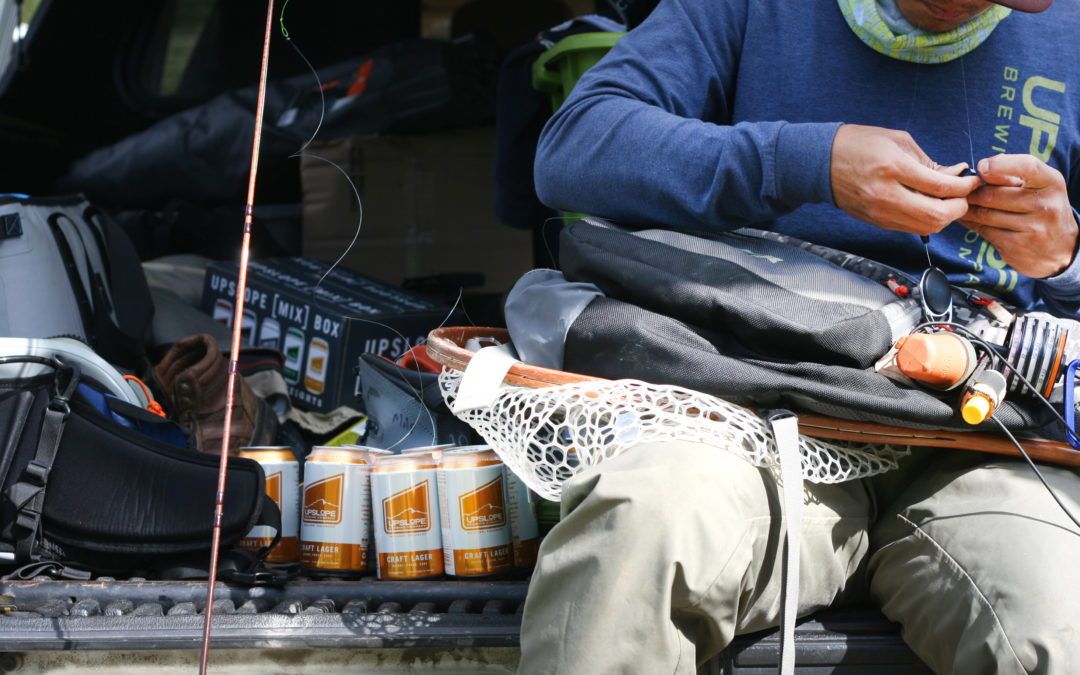
by Pursuit | May 7, 2024 | Conservation, Fishing
Why a brewer of fine beers is fighting to keep our water sparkling, our trout frisky, and our brews crisp.
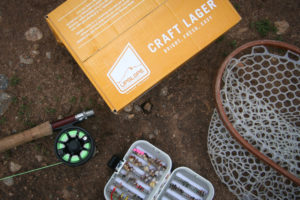
Way back when, about 11 years ago, long before quality craft beer in a can was much of a thing, Upslope co-founder Henry Wood was catching up with his old NOLS instructor colleague and pal Tom Reed—Trout Unlimited’s Angler Conservation Program Director—over a beer. Reed wanted to take the conservation group’s 1% For Rivers program national. And Wood was gearing up to do the same with their new Colorado born Craft Lager. If you’re envisioning some affirmative head-nodding you have the right idea. The gist of it? Buy a Craft Lager and one percent of the gross sales goes to the Trout Unlimited chapter in the state where you bought it. That’s “gross” not “net,” which translates to no small sum. Since just 2015, Upslope has donated $60,000 to the cause. “Beer and trout have a lot in common,” says Reed. “They both depend on clean water.”
Fishing and Craft Lager, A Great Pairing
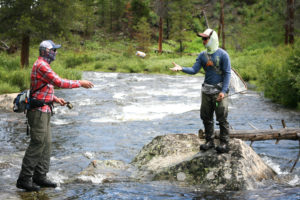
What you drink matters. That’s true regardless of your passions, but if you’re into fly fishing, it’s especially relevant. Why wouldn’t you buy a beer that helps restore and protect rivers? Also, Craft Lager comes in cans, which are the perfect vessels for your vessel. Cans are lighter to ship, reducing the carbon footprint, and they’re easier to recycle than glass. There’s almost no waste: If Americans recycled every can, 96 percent of that aluminum would get repurposed. As for pairing, it doesn’t hurt that this crisp, straw-colored lager is sessionable. “It’s an easy drinking, 4.8 percent alcohol, American made all grain lager,” says Wood. “It’s tough to crush higher alcohol IPAs and steer a driftboat.”
The Upslope Crew Walks the Talk
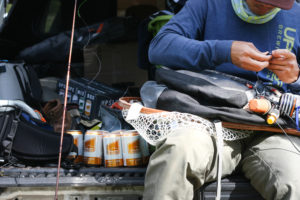
Just as it’s hard to find a mountain biker or hiker that doesn’t see the value of spending an afternoon standing in a cold stream with a rod in hand, it’s hard to find an Upslope employee that isn’t willing to wade into river conservation work. “Beyond our donations to Trout Unlimited, we’ve physically done stream restoration as a company for years,” says Wood. “We coordinate with Rocky Mountain Anglers here in Boulder on Boulder Creek, and on South Boulder Creek in Eldorado Canyon State Park pulling out weeds and rebuilding banks. Our employees get two paid days off a year to donate their time to nonprofit work.”
The Smith River Thanks You
Like the Grand Canyon is to whitewater boaters, the Smith River in Central Montana is to fly fishers—one of the crown jewels. As such, it’s the only float in the nation that requires a permit—which you draw for much like choice elk habitat. To call that float “coveted” would be an understatement. But now a proposed hard rock copper mine on Sheep Creek near the put-in for the Smith is jeopardizing that storied waterway. With money that comes in part from Craft Lager sales, Trout Unlimited is paying lawyers to fight the Australian company pushing the mine and hiring an educator to travel the state singing the virtues of the Smith. “There’s a checkered history of hard rock mining in the state of Montana,” says Reed. “But even though Montana’s mining laws are friendly to international corporations we’ve given them a good fight. We don’t think that’s an appropriate place for a mine. And we aren’t alone. We have good grounds for a lawsuit. I’m hopeful that with continued support t we’ll win.”
Upslope’s Commitment Has Only Grown
Upslope is now one of only two certified B Corp breweries in Colorado, and one of only about 30 worldwide. What’s that mean for the average fly fisher in search of malted beverages? A lot actually. B Corp status depends on a commitment to three overarching promises to take care of employees, the community that the business touches, and the environment. Because Upslope has been committed to such goals since day one, it earned B Corp certification on the first bid. Now the challenge is to constantly improve to meet B Corp’s evermore exacting standards. Much of that challenge falls on Upslope Sustainability Coordinator Elizabeth Waters—who started out at the brewery in the tasting room as a bartender with an environmental degree. “Our biggest blind spot was our supply chain,” says Waters. “Unlike employee benefits and environmental initiatives, we didn’t have any set policy around how we source materials. Now we’re chipping away at it vigorously. It’s the little things that add up. And those little actionable initiatives get identified by our employees. Like when a hops supplier recently switched from non-recyclable paper bags lined with plastic to full paper. That simple move keeps tons of waste from the landfill. We hope to be 85 percent to our zero waste soon.”

Check Out Upslope Brewing
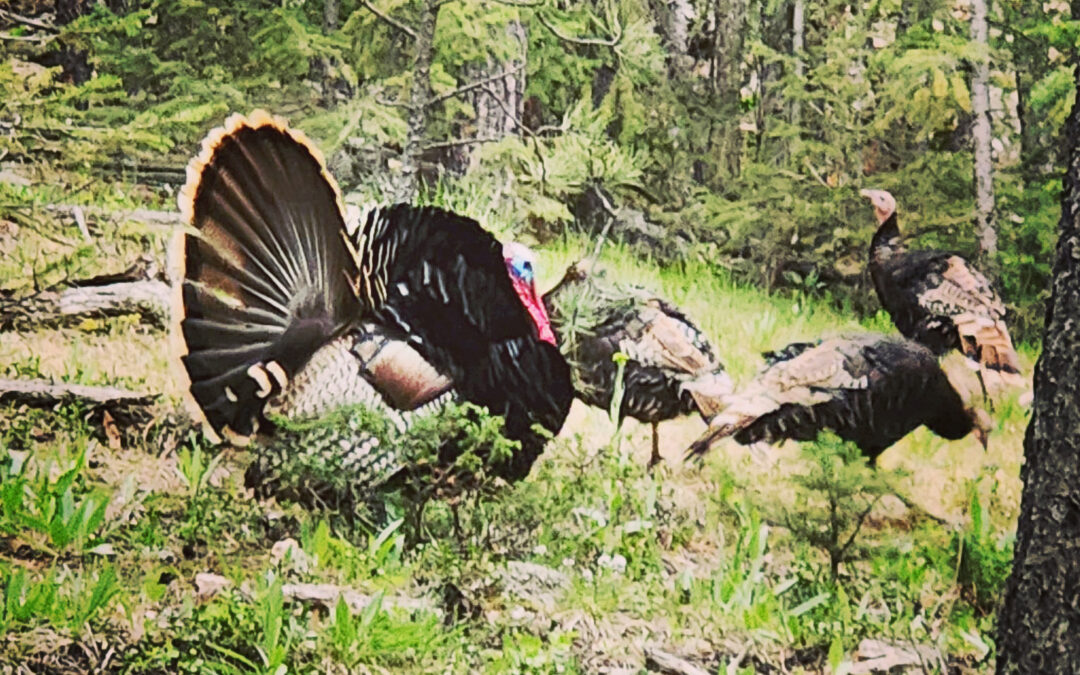
by Pursuit | Mar 13, 2024 | Hunting, Inside Pursuit
Springtime brings about a sense of renewal and rejuvenation, not just for nature but for avid hunters as well. As the days grow longer and the landscape bursts into life, it’s time for turkey hunters to gear up for an exhilarating pursuit. However, mastering the art of spring turkey hunting requires more than just enthusiasm; it demands strategy, patience, and access to the right resources. Fortunately, modern technology has revolutionized the hunting experience, and one such tool that has gained traction among hunters is the Infinite Outdoors app.
Spring turkey hunting is a thrilling yet challenging pursuit. Turkeys are known for their keen senses and elusive nature, making them a worthy adversary for hunters. During the spring season, turkeys are actively breeding, which means they are more vocal and responsive to calls. This behavior offers hunters a unique opportunity to engage with these birds, but it also requires a deep understanding of turkey behavior and habitat.
Enter the Infinite Outdoors app, a comprehensive tool designed to enhance the hunting experience while giving hunters access to prime private land hunts. From scouting and strategizing to booking some of the countries premiere private land, this app serves as a one-stop solution for all your turkey hunting needs (and of course far more species).
One of the key elements of a successful hunt is finding the right area to hunt. With Infinite Outdoors database of private land plots across the country which gives Turkey hunters access to some of the best hunting properties without the fight of a public lands hunt. On each property page they also list habitat information which is critical to understanding the landscape.
Once in the field, the app’s tracking features come into play. Ensuring that you are hunting within the boundaries of the private land plot you have access too and less time worrying about potentially being in that “wrong” spot.
Hunting is not just a solitary activity; it’s a community-driven endeavor. The Infinite Outdoors app fosters camaraderie among hunters by allowing them to connect with like-minded individuals. Users can share pictures from their hunt or coordinate group hunts through the app’s social features, creating a sense of belonging and solidarity within the hunting community. I’ve personally used this feature to invite friends on these hunting adventures and its a unique way to connect through technology to truly share a memorable experience.
Safety should always be a top priority when engaging in any outdoor activity, and hunting is no exception. The Infinite Outdoors app provides users with up-to-date information on hunting regulations, season dates, and safety guidelines specific to their location. This ensures that hunters stay compliant with local laws and regulations while enjoying their hunting adventures responsibly.
Spring turkey hunting is a time-honored tradition that requires skill, patience, and a deep appreciation for the natural world. With the Infinite Outdoors app, hunters have a powerful tool at their disposal to enhance their hunting experience. So, gear up, download the app, and embark on your next turkey hunting adventure with confidence and excitement!
INFINITE OUTDOORS

by Pursuit | Mar 2, 2024 | Conservation, Hunting
Turkey hunting requires not only skill in tracking and concealment but also in understanding and mimicking turkey vocalizations. Mastering turkey sounds can significantly increase your success in the field. Here’s a guide to common turkey vocalizations and how to replicate them:
Gobble:
Description: The gobble is the most well-known turkey sound, typically made by male turkeys (gobblers) to attract hens and establish dominance.
How to Mimic: Inhale deeply and forcefully, then let out a burst of air while making a deep, guttural sound. Use a turkey call such as a box call, slate call, or mouth call to produce a realistic gobble.
Cluck:
Description: Clucking is a short, sharp sound made by both male and female turkeys. It’s used for communication within flocks and to maintain contact.
How to Mimic: Make a series of short, sharp, staccato sounds with your tongue against the roof of your mouth. You can also use a box call or mouth call to produce clucks.
Yelp:
Description: Yelps are the most common turkey vocalizations and are made by both males and females. They are used for communication within the flock and to locate one another.
How to Mimic: Make a series of clear, high-pitched notes with a rising and falling cadence. Use a box call, slate call, or mouth call to replicate yelps accurately.
Purrs:
Description: Purrs are soft, rolling sounds made by turkeys when they are content or feeding. They can also be used as a reassuring sound.
How to Mimic: Purrs are best mimicked by softly rolling your tongue against the roof of your mouth while exhaling gently. You can also use a friction call like a slate call to produce purring sounds.
Kee-kee:
Description: The kee-kee is a high-pitched, whistling sound made by young turkeys (poults) to maintain contact with each other or when they are lost.
How to Mimic: Make a series of high-pitched, whistle-like notes with a descending cadence. Mouth calls are often used to mimic kee-kees effectively.
Tips for Effective Turkey Calling:
1. Practice Regularly: Mastering turkey calls takes practice, so spend time practicing different calls until you can produce realistic sounds.
2. Start Soft: Begin your calling sequences softly, gradually increasing volume and intensity as needed.
3. Use Realism: Pay attention to the cadence, rhythm, and pitch of turkey sounds, and try to replicate them as accurately as possible.
4. Call Sparingly: Avoid overcalling, as this can spook turkeys. Call only when necessary to keep the birds interested and engaged.
5. Stay Concealed: Always ensure you’re well-concealed while calling to avoid being detected by wary turkeys.
By mastering these turkey sounds and using them effectively in the field, you’ll significantly increase your chances of success while turkey hunting.

by Pursuit | Feb 3, 2024 | Hunting
Duck hunting can be an exhilarating outdoor activity, and successful hunts often involve a combination of skill, strategy, and knowledge of waterfowl behavior. Here are some top duck hunting tactics to improve your chances of a successful hunt.
Scouting
– Identify prime locations where ducks frequent. Look for feeding areas, roosting spots, and travel routes.
– Use binoculars to observe duck behavior, flight patterns, and feeding habits.
– Visit potential hunting spots before the season to understand the terrain.
Decoy Placement
– Set up realistic decoy spreads to attract ducks. Mimic natural groupings and spacing.
– Consider using motion decoys (such as spinning-wing decoys) to add realism to your spread.
– Adjust decoy placement based on wind direction and the position of the sun to make your spread more convincing.
Concealment
– Blend into your surroundings by using natural cover such as brush, tall grass, or layout blinds.
– Avoid moving unnecessarily, as ducks are quick to detect movement.
– Use camouflage clothing that matches the surrounding environment.
Calling Techniques
– Practice a variety of duck calls to mimic different sounds, including quacks, feeding calls, and comeback calls.
– Use calling sparingly and pay attention to the ducks’ response. Sometimes silence is more effective.
– Observe the ducks’ behavior and adjust your calling accordingly.
Weather Awareness
– Pay attention to weather conditions, as they greatly influence duck behavior.
– Overcast days, light rain, or foggy conditions can make ducks more active and likely to fly.
– Strong winds may alter flight patterns, and cold temperatures can push ducks to feed more frequently.
Timing
– Hunt during peak migration times for the best chances of encountering large flocks.
– Be in your blind or setup well before sunrise, as ducks often start moving early in the morning.
Retrieval Dogs
– Train and use a well-trained retriever to fetch downed ducks. This can minimize the chances of losing birds and help with efficiency.
Legal Regulations
– Familiarize yourself with local hunting regulations, including bag limits, shooting hours, and specific rules for the area you are hunting.
Stay Flexible
– Ducks can be unpredictable, so be prepared to adapt your strategy based on changing conditions.
– Move to different spots or change decoy setups if you notice ducks are not responding as expected.
Remember, ethical and responsible hunting practices are essential for the conservation of waterfowl populations and the enjoyment of the sport by future generations. Always prioritize safety and adhere to hunting regulations.
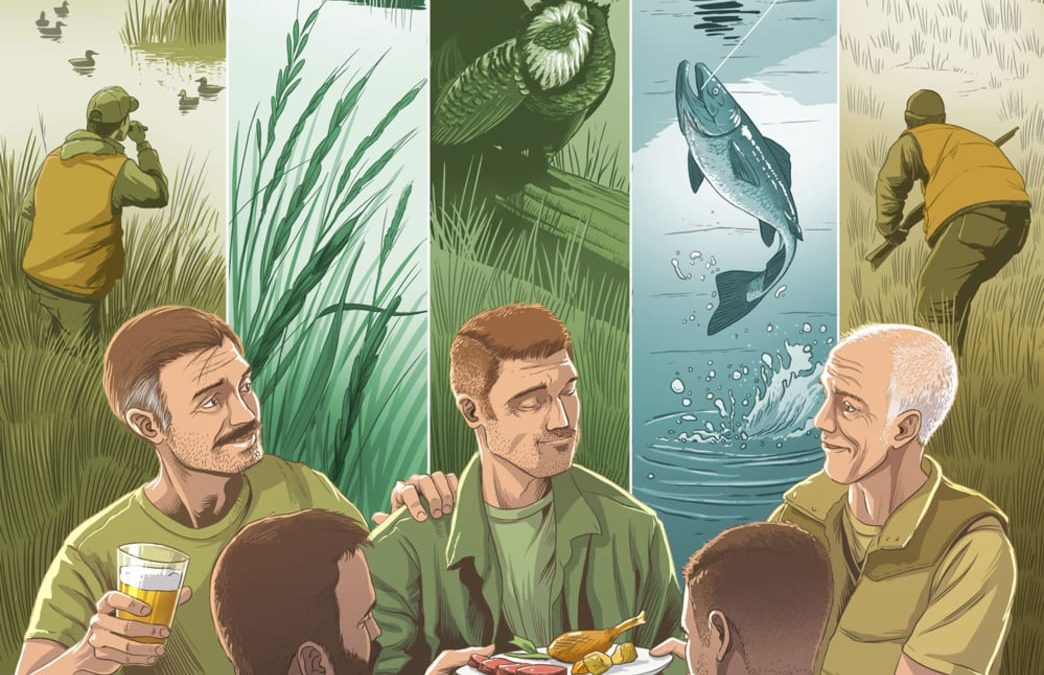
by Pursuit | Feb 3, 2024 | Hunting, Inside Pursuit
No matter if it’s a gourmet feast or a rustic camp supper, a family meal of shared wild game has always brought hunters together
The dusky grouse came from the big slopes of the Flathead and Kootenai national forests, behind Tom Healy’s house in the Northern Rockies. When Fast Eddie, Healy’s wirehaired pointing griffon, locked up along an edge of pines, Healy knew instantly and intuitively that it was no ruffed grouse. “The big duskies like that sunshine, that open ground in the big woods,” he says, standing in the deep shade of a wall tent, stirring a mixture of grouse meat, elk meat, and wild rice. “I knew what was coming.”
Healy harvested this wild rice too, with his wife, in a canoe deep in Minnesota’s Boundary Waters. Now he stirs the dirty rice in a black iron pot as he describes arrowing through the dense rice stalks in the canoe, knocking the grains loose with short wooden batons so they fell into the boat.
There is elk heart in Healy’s dirty rice mix too, and elk sausage from a cow he killed eight days into a Big Hole Valley backcountry hunt. He had a .270 in camp, he recalls, but he carried a slug gun that day. “I wanted to force myself to get a little closer,” he says. “Make it a little more real.”
I glance around the tent. Nearby, a tall, bearded, cowboy-hatted guy sears mallard breasts from a Rocky Mountain spring creek. Another outdoorsman debones a Bristol Bay salmon. There is snowshoe hare and Idaho chokecherry sauce and goose confit in the works. On an open fire outside the tent, skewers of lynx meat sizzle. Getting closer to the heart of the matter seems to be the dish of the day. I’m in Boise, Idaho, at what is arguably the world’s most impressive wild-game meal: the Backcountry Hunters & Anglers field-to-table dinner, held during the group’s annual Rendezvous. Each year, some of the country’s best wild-game cooks put on a fundraiser feast so fine, it’s been written up in gourmet-cooking magazines.
I wander from camp stove to fire pit, sampling beaver meatballs and smoked Lahontan cutthroat trout. I quiz the chefs about each dish, but what I hear most isn’t the merits of wild plums versus the grocery-store variety, or why jackrabbit is underrated on the table. Instead, everyone tells me a story about the harvest. I hear how warm it was that January day on the Boise River when the trout were biting, how the moon lit the trail on the tough hike out with the elk quarters.
It’s been this way, always. This might be one of the fancier wild-game gigs I’ve ever attended, but I’ve felt this same kinship in Cajun squirrel camps, Yukon duck camps, and my deer camp back home. It’s what we do. The earliest art, religion, and connections between human communities were all rooted in the things we chase, kill, and eat. And share.
Spice of Life
Here’s another story: A few years ago, my wife, Julie, and I had new friends over for dinner. I smoked a chunk of pronghorn backstrap and served it with Gouda cheese and red peppers blackened on the grill. It was not terribly different from our normal wild fare. To our guests, though, antelope was the most exotic meat they’d ever eaten. They gushed about its tenderness and sage-tinted bite. They wanted to know where I’d killed it (Wyoming) and how (arrowed from behind a decoy). They asked about my other hunts. They were surprised to learn that I butchered my own deer and aged ducks in the refrigerator’s vegetable crisper. They were unaware of the modern hunter’s connection to this ancient cycle, that wild meat still nourishes soul as much as body.
I asked if they’d like to meet their meal, since the antelope’s head was hanging on my office wall. They politely declined, but still, that one simple meal sparked a conversation about hunting, sustainability, and the honesty of eating what you kill. They still talk about it. Not every wild-game dinner is a conversion experience, to be sure. Sometimes you just want to chew on a squirrel leg. But there’s no doubt that a grilled backstrap is as fine an argument for hunting and fishing as any philosophical treatise.
At the BHA chow-down, I hover over Idaho chef Randy King as he works up a dish of spring rolls stuffed with goose confit. Always a sucker for a good goose dish, I’m about to ask for the particulars of the dish, but King tells a different story. “This is kind of funny,” he says, “in sort of a bad-funny way.” He tells me that he and his 12-year-old son, Cameron, hunted these geese from a southwestern Idaho farm ditch last winter. Cameron was shooting a single-barrel 20-gauge, the kind with an exposed hammer, and with the first shot, the hammer bit the boy on the cheek hard enough to require stitches. Blood gushed. “I felt awful,” King says, “but he is so proud of that scar, you wouldn’t believe it.”
But I would, of course. What hunter wouldn’t? It’s the kind of story that seasons a meal and life long after the hunt, and makes every day on this Earth a sweeter bite of life.
Gear Tip: Cooking by the Book
Time to make some room on your bookshelf. Randy King’s collection of recipes and essays, Chef in the Wild: Reflections and Recipes from a True Wilderness Chef is pretty close to sharing a cooking fire with the Idaho icon. And the latest cookbook from award-winning food author Hank Shaw, Pheasant, Quail, Cottontail: Upland Game from Field to Table, elevates gamebird and small-game cookery to its rightful status.
Written by T. Edward Nickens for Field & Stream and legally licensed through the Matcha publisher network. Please direct all licensing questions to legal@getmatcha.com.
Featured image provided by Field & Stream









